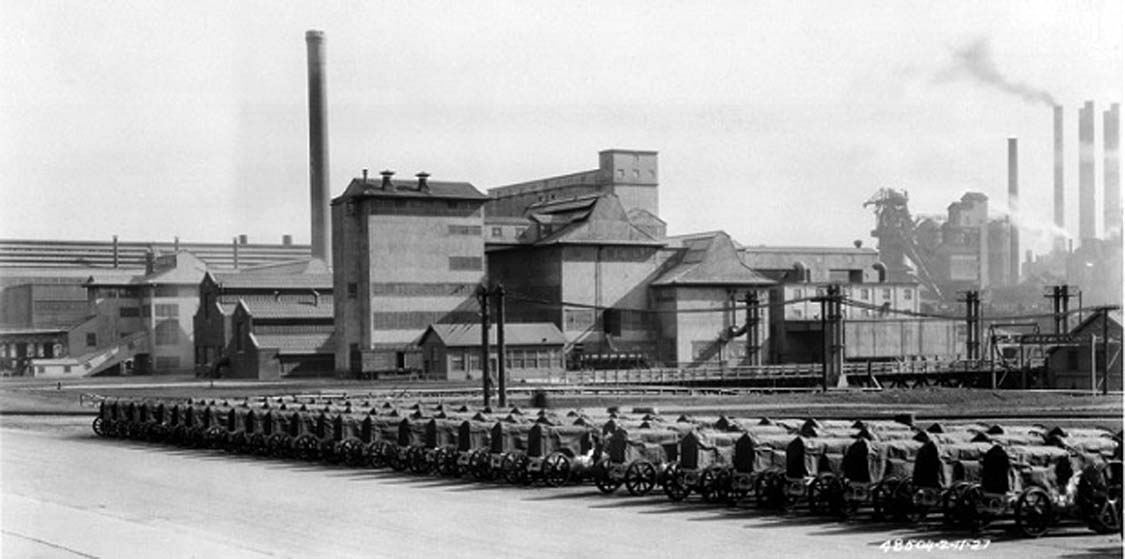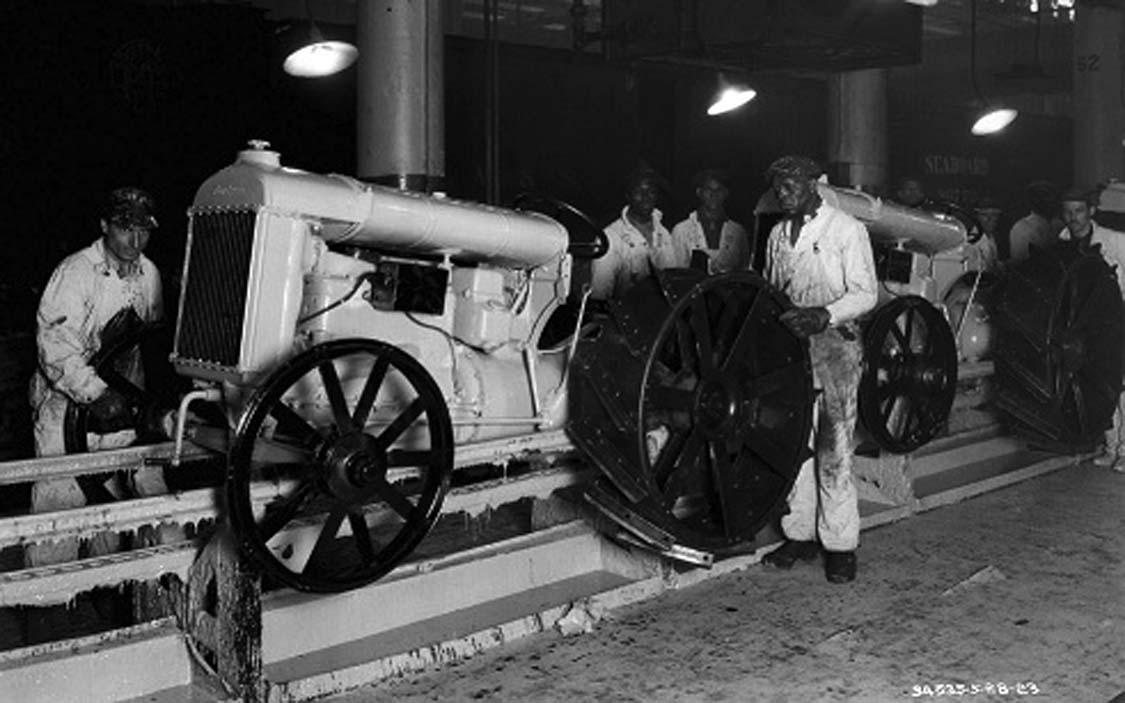Posted 08-11-2015 at 09:12:32 [URL] [DELETE]
[Reply] [Email]
Ford Begins Tractor Production at the Rouge
DEARBORN - On Feb. 23, 1921, Ford Motor Company began consumer tractor production at the Rouge site in Dearborn. Ford tractors at the Rouge, 1927:
 Employees on the Tractor Assembly Line, 1923:
 Below is a timeline of the company’s strong tractor heritage: 1905-1907
Henry Ford builds his first gasoline-powered experimental tractor, called the "automobile plow." The tractor uses parts from Ford Model B and Model K cars. The tractor project is undertaken by Henry Ford, personally, not Ford Motor Company. circa 1913-1917
Henry Ford builds several experimental tractors based on the Model T. 1916
First experimental Fordson built at Highland Park Plant. July 27, 1917
Henry Ford and Son incorporated. 1917
The British Government request assistance from Mr. Ford in building a large number of tractors to help raise urgently-needed food to counteract the effect of enemy blockade during World War I.
Oct. 8, 1917
First production Fordson assembled at a new tractor plant in Dearborn, at Michigan Ave. and Brady St. 1918
Fordson offered for sale in the U.S. for the first time. 
July 3, 1919
First Fordson built at the new Cork, Ireland plant. 1921
Tractor production moved from Dearborn Tractor Plant to the Rouge. Dec. 29, 1922
Fordson production ceases at Cork plant 1929
Ford tractor manufacturing transferred from the Rouge back to Cork, Ireland plant. April 1, 1929
The first new Model N tractor produced at Cork Plant. 1932
Tractor manufacturing transferred from Cork to Dagenham, England plant.
June 19, 1939
Ford announces a new Ford tractor with the Ferguson system. Henry Ford and Harry Ferguson agree that Ford will produce the tractors while Ferguson will market the tractors, along with implements sourced from other manufacturers. Their agreement is purely verbal.
1939
Production of the 9N tractor begins at the Rouge. It is one of the world's first production tractors with a three-point hitch and a hydraulic system that allows the operator to raise or lower attached implements by hydraulic controls. This is the first tractor produced in the U.S. since 1929.
Nov.10, 1943
The 100,000th tractor produced at Dagenham since the outbreak of World War II comes off the line. 1947
Ford announces its new 8N tractor. The company terminates its agreement with Harry Ferguson. 1948
Harry Ferguson files suit against Ford for patent infringement. After a long and complex trial, Ferguson receives a $9.25 million settlement in 1952.
Sept. 29, 1951
The first New Fordson Major, the E1A, is produced at Dagenham. This British tractor is an international success, exported to over 100 countries. 1953
Ford markets a 50th-anniversary tractor, the Golden Jubilee NAA. Aug. 1, 1953
Ford Tractor Division is established to market tractors and equipment in the U.S. This is the first time that Ford has marketed a full line of agricultural equipment. Jan. 15, 1954
Ford Tractor Division renamed Ford Tractor and Implement Division. Jan. 6, 1955
Five new Ford tractor models in two power series are introduced, the first time the company has produced multiple models at the same time. June 8, 1955
The Ford Tractor and Implement Division opens a Farm Machinery Research and Engineering Center in Birmingham, Michigan. 1959
Ford introduces the Select-O-Speed transmission planetary, which has ten forward and two reverse speeds and allows for shifting "on-the-go" without a clutch. March 21, 1961
Ford Tractor Operations organized to coordinate U.S. and European tractor operations.
1962
Blue and white selected as standardized colors for Ford farm tractors. 1964
Manufacturing and assembly operations begin at new plants in Basildon, England and Antwerp, Belgium.
Oct.10, 1964
Ford introduces a single series of tractor models for worldwide markets. Tractors for the U.S. market are built at the newly-revamped Highland Park plant. Tractors for Europe are built at Antwerp, while those for the U.K. and the rest of the world are built at Basildon. Known as the 6X range, the first models are the 2000, 3000, 4000 and 5000. 1968
New model 8000 tractor is introduced. It's the largest and most-powerful Ford farm tractor to date.
May 18, 1972
The four-millionth Ford Motor Company tractor comes off the line at Highland Park.
1975
The 7A line, also called the 600 series, debuts. It consists of 24 new agricultural tractors ranging from 30- to 86-hp.
Sept. 14-16, 1981
The new series 10 tractors are introduced in Geneva, Switzerland. February 14, 1985
Ford announces a plan to move production of all four-cylinder agricultural tractors to Basildon. Antwerp will build TW tractors. Romeo will continue to build three-cylinder agricultural tractors, as well as industrial and utility models for North America.
Oct. 10, 1985
Ford announces its acquisition of Sperry New Holland, manufacturers of a wide range of agricultural equipment.
Nov. 11, 1986
Ford announces that it will close its Romeo plant. Jan. 1, 1987
Ford New Holland, Inc. is formed as the agricultural and industrial equipment subsidiary of Ford Motor Company. 1987
Ford New Holland acquires Versatile Farm Equipment Company, a Canadian manufacturer of tractors and harvesting machinery
May 23, 1988
The Basildon Plant celebrates 25 years of production with a visit from HRH Princess Anne.
1991
Ford New Holland merges with Fiat Geotech. Ford receives a 20 percent share of the company, while Fiat receives 80 percent.
| 

